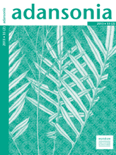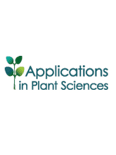
ACTA BIOLOGICA CRACOVIENSIA SERIES BOTANICA
Scope & Guideline
Fostering a deeper understanding of our botanical heritage.
Introduction
Aims and Scopes
- Plant Morphology and Anatomy:
Research exploring the structural features of plants, including studies on leaf and flower morphology, as well as anatomical adaptations to environmental stresses. - Plant Physiology and Biochemistry:
Investigations into physiological processes within plants, such as photosynthesis, stress responses, and the role of phytohormones like melatonin. - Taxonomy and Systematics:
Studies aimed at classifying and understanding the evolutionary relationships among plant species, with a focus on pollen morphology and chromosome analysis. - Environmental Botany:
Research assessing plant responses to environmental factors, including stress from salinity, heavy metals, and light conditions, as well as implications for ecosystem health. - Genetic Studies and Biotechnology:
Explorations of genetic diversity, gene transfer, and biotechnological applications in plant breeding and conservation efforts.
Trending and Emerging
- Plant Stress Response Mechanisms:
Increased focus on how plants cope with abiotic stressors, such as heavy metals and salinity, indicates a growing interest in understanding plant resilience and adaptation. - Molecular and Genetic Approaches:
Research utilizing molecular techniques, including gene knockout studies and genetic analysis, is on the rise, emphasizing the integration of biotechnology in plant research. - Ecological and Environmental Interactions:
There is a notable trend towards studies examining the interactions between plants and their environment, particularly in relation to climate change and habitat restoration. - Conservation and Endemism:
An increasing number of studies are dedicated to the conservation of endemic and rare plant species, highlighting the journal's commitment to biodiversity and ecological preservation.
Declining or Waning
- Traditional Taxonomic Studies:
While taxonomy remains important, there has been a decrease in papers solely focused on traditional taxonomic classifications without integrating molecular techniques or ecological contexts. - Invasive Species Research:
Research on invasive plant species has been less prominent, possibly due to a shift towards more urgent ecological issues like climate change and habitat loss. - Historical Botany:
The focus on historical or paleobotanical studies appears to be waning, as current research trends lean towards contemporary environmental issues and applied research.
Similar Journals

BOTANICAL REVIEW
Elevating ecological perspectives in botanical studies.BOTANICAL REVIEW is a highly esteemed journal published by SPRINGER, renowned for its commitment to advancing the fields of Ecology, Evolution, Behavior and Systematics and Plant Science. Established in 1935, this journal has become a cornerstone for researchers and professionals, reflecting over eight decades of rigorous scholarship. With an impressive impact factor and ranking within the top quartile for both its fields—Q1 in Ecology, Evolution, Behavior and Systematics and Plant Science—BOTANICAL REVIEW remains a key platform for disseminating critical findings and fostering scientific dialogue. Although it is not an open-access journal, its accessibility through institutional subscriptions enhances its reach among the academic community. The journal not only emphasizes the ecological aspects of plant life but also integrates evolutionary context to inform current practices and theories in botany. With a dedication to exploring the complex interactions within botanical sciences, BOTANICAL REVIEW continues to shape the future of plant research.

ADANSONIA
Connecting scholars for a greener tomorrow.ADANSONIA is a distinguished, peer-reviewed open access journal dedicated to advancing the field of plant science. Published by the Publications Scientifiques du Museum in Paris since 2000, this journal serves as a critical platform for sharing innovative research and discoveries in botany, ecology, and related disciplines. With its ISSN 1280-8571 and E-ISSN 1639-4798, ADANSONIA boasts a notable Scopus rank of #383 in the Agricultural and Biological Sciences category and a 2023 category quartile ranking of Q3 in Plant Science, indicating a meaningful contribution to the academic community. The journal's scope encompasses a broad range of topics, making it a vital resource for researchers, professionals, and students alike who are exploring the complexities of plant biology. Based in France, ADANSONIA not only enhances visibility for groundbreaking research but also facilitates open communication amongst scholars, ensuring that knowledge on plant science is accessible worldwide. Located at CP 39-57, Rue Cuvier, F-75231 Paris Cedex 05, France, this journal stands as a testament to the collaborative efforts in the pursuit of scientific excellence in plant sciences.

BRITTONIA
Championing Ecological Understanding in Plant StudiesBRITTONIA, published by Springer, stands as a reputable journal dedicated to advancing the fields of botany and plant sciences. With a storied history dating back to 1931, this journal has evolved to embrace contemporary research spanning various aspects of plant biology, ecology, and systematics. Focusing on a comprehensive analysis of both ecological interactions and plant systematics, BRITTONIA plays a crucial role in disseminating knowledge among researchers and professionals committed to understanding plant life and its environmental contexts. Despite its open access status being currently unavailable, the journal ensures wide accessibility through institutional subscriptions. In the latest rankings, it proudly holds a Q2 category in Plant Science and a Q3 category in Ecology, Evolution, Behavior, and Systematics, indicating its growing influence and academic rigor. Researchers and students alike will find BRITTONIA an essential resource for the latest findings and discussions in plant sciences.

Applications in Plant Sciences
Empowering Scholars in Plant Science and EcologyApplications in Plant Sciences is a prestigious journal published by WILEY, dedicated to advancing the field of plant science and ecology through original research and comprehensive reviews. With an impressive impact factor that places it in the Q1 category in both Ecology, Evolution, Behavior and Systematics, and Plant Science, the journal stands as a pivotal resource for scholars and practitioners. Since its establishment in 2013, it has embraced an Open Access model, ensuring that vital research is accessible to a global audience. The journal’s rigorous peer-review process and its commitment to high-quality content make it a leading platform for disseminating relevant findings, innovative methodologies, and cutting-edge technologies. Recognized in the Scopus rankings among the top percentile of journals, Applications in Plant Sciences continues to foster collaboration and inspire further studies that address the challenges and opportunities in plant biology. Researchers, students, and professionals alike will find this journal indispensable in keeping abreast of advancements and engaging with the forefront of plant science research.

NEW ZEALAND JOURNAL OF BOTANY
Unraveling Nature's Mysteries, One Study at a TimeThe New Zealand Journal of Botany, published by the esteemed Taylor & Francis Ltd, serves as a pivotal platform for disseminating significant research in the fields of Ecology, Evolution, Behavior and Systematics, as well as Plant Science. With a rich history dating back to 1963 and an impressive convergence extending to 2024, this journal has established itself as an essential resource for researchers and professionals dedicated to understanding the complexities of plant life and ecological systems in New Zealand and beyond. The journal is currently categorized in the Q3 quartile for both relevant disciplines as of 2023, reflecting its balanced influence within the global academic community. Although not an open access journal, it retains a significant impact factor, evidenced by its Scopus rankings, which place it within the top half of its categories. This makes it an invaluable tool for students, researchers, and academics aiming to engage with robust, peer-reviewed scientific findings and contribute to the evolving discourse surrounding botany and ecological research.

BOTANICAL JOURNAL OF THE LINNEAN SOCIETY
Cultivating Insights into Plant Biology and EcosystemsThe Botanical Journal of the Linnean Society, published by Oxford University Press, stands as a premier platform for interdisciplinary research within the realms of Ecology, Evolution, Behavior, and Plant Science. With a notable impact factor reflective of its esteemed reputation, this journal is classified in the Q1 quartile for both Ecology and Plant Science, placing it among the most influential publications in these fields. Since its inception in 1969, and with an anticipated convergence of research extending to 2024, it has become essential for scholars and professionals seeking to engage with cutting-edge studies, theoretical frameworks, and practical applications that drive our understanding of plant biology and ecological systems. The journal’s commitment to excellence is underscored by its robust Scopus rankings—achieving an impressive 83rd percentile in Ecology and a 82nd percentile in Plant Science. This makes the Botanical Journal of the Linnean Society a crucial resource for researchers, educators, and students alike, eager to advance their knowledge and contribute to the evolving discourse in botany and environmental studies.

Botanical Studies
Promoting Accessible Knowledge in Plant StudiesBotanical Studies is a premier open-access journal published by Springer, dedicated to the field of botany and plant sciences. Since its establishment in 2006, the journal has championed innovative research and scholarship that explores diverse botanical topics ranging from plant systematics to ecology and conservation. With a commitment to broad accessibility, it promotes the dissemination of knowledge to researchers, professionals, and students worldwide. Botanical Studies fosters academic collaboration and dialogue, contributing significantly to the global botanical community. Its open-access policy allows unrestricted access to its high-quality, peer-reviewed content, ensuring that vital research is available to all. Join the growing community of scholars advancing botanical science through this essential publication, conveniently located at One New York Plaza, Suite 4600, New York, NY 10004, United States.

PAKISTAN JOURNAL OF BOTANY
Elevating Botanical Knowledge for a Sustainable FuturePakistan Journal of Botany, published by the Pakistan Botanical Society, is a leading platform for the dissemination of high-quality research in the field of plant sciences. Established in 1978 and with its most recent issues available until 2024, this journal has been pivotal in enhancing our understanding of botany, particularly in the South Asian context. With an ISSN of 0556-3321 and E-ISSN of 2070-3368, it serves a global readership, appealing to researchers, practitioners, and students alike. The journal is ranked in Q3 of the Plant Science category for 2023, indicating its scholarly significance, and it holds a position in the 51st percentile of its Scopus ranking. While currently offering limited open access, the journal continues to strive for broader accessibility to foster knowledge dissemination. Research published in the Pakistan Journal of Botany covers diverse topics, including but not limited to plant physiology, ecology, and conservation, making it an invaluable resource for anyone engaged in plant science research.

SOUTH AFRICAN JOURNAL OF BOTANY
Connecting Researchers to the Heart of Plant ScienceThe SOUTH AFRICAN JOURNAL OF BOTANY, published by Elsevier, is a distinguished peer-reviewed journal that serves as an essential platform for the dissemination of high-quality research in the field of plant science. With an ISSN of 0254-6299 and an E-ISSN of 1727-9321, this journal has been a vital contributor to the scientific community since its inception in 1982, continuing to publish pivotal research findings up to 2024. Recognized in the Q2 category of Plant Science for 2023, and ranked 106 out of 516 in Scopus, this journal occupies the 79th percentile in its field, reflecting a strong commitment to advancing botanical sciences. Although it is not an open-access publication, it provides crucial insights and advancements that benefit researchers, professionals, and students alike. As the journal continues to evolve, it remains an invaluable resource for those dedicated to exploring the complexities of plant biology within the broader scope of agricultural and biological sciences.

ACTA SOCIETATIS BOTANICORUM POLONIAE
Advancing Plant Science Through Open Access ResearchACTA SOCIETATIS BOTANICORUM POLONIAE is a reputable open-access journal dedicated to the field of Plant Science, published by the Polskie Towarzystwo Botaniczne since 1923. With an ISSN of 0001-6977 and an E-ISSN of 2083-9480, this journal has made significant contributions to the botanical sciences, fostering the dissemination of research from Poland and beyond. The journal has ranked in the third quartile (Q3) within its category in the 2023 journal metrics, demonstrating a strong presence in the global academic community, as evidenced by its Scopus ranking of 291/516 within the Agricultural and Biological Sciences sector, placing it in the 43rd percentile. While specific H-Index data are currently not available, ACTA continues to attract submissions from a broad international audience and publishes a wide range of studies that advance the understanding of plant biology, ecology, and conservation. The journal remains a vital resource for researchers, professionals, and students alike, committed to enhancing knowledge and collaboration in botanical science.